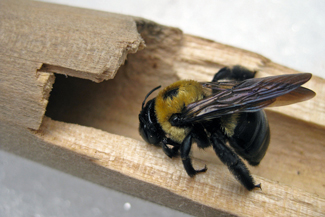Carpenter Bees and IPM
By Chris Williams on May 13, 2015.

Carpenter bee which had hollowed out the handle of a shovel.
I’ve been working in this industry for thirty years up here in Northern New England, and yet only for about half of that time have I been dealing with carpenter bees. Here is a good link from Penn state explaining their biology.
Chemical control of carpenter bees is difficult, time consuming and expensive work, but I wanted to talk about a great IPM method for dealing with carpenter bees. For those of you who may not be familiar with the concept of integrated pest management (IPM), it involves using a combination of tools (both chemical and non-chemical) and practices to manage pests in a cost efficient, environmentally friendly manner.
Now, not every carpenter bee infestation situation in a home is the same, so what I’m about to suggest may not be applicable to some types of home construction (log cabins for example). Over the years, most all of the worst carpenter bee infestations I’ve observed (from periodic re-infestation) in traditionally constructed homes have involved the rake boards on the gables or dormers of the house itself or other structure like a garages or sheds. Often times, woodpeckers will exacerbate carpenter bee damage further, by attacking and digging out developing bees. At this point, the trim boards are subject to further degradation by moisture and wood destroying fungi and should be replaced.
If you are a homeowner facing this type of situation, the absolute best long-term solution is to completely replace the infested trim boards with synthetic versions. You may also consider replacing trim that has not been infested, but may be attacked a bit further down the road if the bees no longer have access to where they’ve been living. I would define this type of approach to carpenter bee management as a form of exclusion, because now the bees have been denied access to this part of the home and they cannot bore through this type of composite board. This is a great non-chemical way to eliminate carpenter bees from these troublesome areas.
There are many different manufacturers out there from which to choose. I’ve had a lot of trim boards replaced with synthetic on my home not because of carpenter bees, but because of weathering (warping/splitting and decay) and so far they’re holding up great. I highly recommend using them.